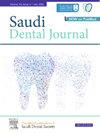Influence of final irrigation with titanium dioxide and silver nanoparticles on the fracture resistance of endodontically treated roots
IF 2.3
Q3 DENTISTRY, ORAL SURGERY & MEDICINE
引用次数: 0
Abstract
Background
Titanium dioxide (TiO2NP) and silver nanoparticles (AgNPs) have been recognized for their ability to enhance the structural integrity of dental materials. This study aimed to compare the influence of these nanoparticles on the structural resilience of treated root canals.
Materials and Methods
The crowns of 75 undamaged central incisors were sectioned below the cemento-enamel junction to achieve a consistent root length of 16 mm. The root canals were prepared using K3 files up to size 40 with a 6 % taper. The specimens were then divided into five groups (n = 15), each subjected to a final irrigation protocol with one of the following solutions: normal saline, 2 % chlorhexidine (CHX), 17 % EDTA combined with 2.5 % sodium hypochlorite (NaOCl), 17 % EDTA with 0.1 % silver nanoparticles (AgNPs), and 17 % EDTA with 0.1 % titanium dioxide nanoparticles (TNPs). After obturation with gutta-percha and sealer, fracture resistance (FR) was evaluated. The data were analyzed using one-way ANOVA and Tamhane’s post hoc test (p < 0.050).
Results
The lowest fracture resistance (FR) was observed in the group treated with ethylenediaminetetraacetic acid (EDTA) combined with sodium hypochlorite (NaOCl), followed by the groups irrigated with normal saline and chlorhexidine (CHX), with no statistically significant difference between the latter two groups (p > 0.05). There was also no significant difference in FR between the CHX and saline groups (p > 0.05). In contrast, irrigation with silver nanoparticles (AgNPs) and titanium dioxide nanoparticles (TNPs) resulted in significantly higher fracture resistance compared to the other solutions tested (p < 0.050).
Conclusion
The fracture resistance of endodontically treated roots was significantly improved when the final irrigation sequence included AgNPs and TNPs nanoparticles. In contrast, sodium hypochlorite (NaOCl) yielded the lowest fracture resistance value.
二氧化钛和纳米银对根管治疗后根抗断性的影响
二氧化钛(TiO2NP)和纳米银(AgNPs)因其增强牙科材料结构完整性的能力而得到认可。本研究旨在比较这些纳米颗粒对治疗后根管结构弹性的影响。材料与方法将75个未损伤的中切牙冠切至牙髓-牙釉质交界处下方,使牙根长度保持在16mm。根管预备使用K3锉,尺寸为40,锥度为6%。然后将标本分为五组(n = 15),每组接受以下溶液之一的最终冲洗方案:生理盐水,2%氯己定(CHX), 17% EDTA与2.5%次氯酸钠(NaOCl), 17% EDTA与0.1%银纳米粒子(AgNPs), 17% EDTA与0.1%二氧化钛纳米粒子(TNPs)。用杜仲胶和密封剂封堵后,评估抗骨折性(FR)。采用单因素方差分析和Tamhane事后检验(p <;0.050)。结果乙二胺四乙酸(EDTA)联合次氯酸钠(NaOCl)治疗组骨折阻力(FR)最低,其次为生理盐水和氯己定(CHX)冲洗组,后两组间差异无统计学意义(p >;0.05)。CHX组和生理盐水组之间FR也无显著差异(p >;0.05)。相比之下,用纳米银粒子(AgNPs)和二氧化钛纳米粒子(TNPs)灌溉,与其他测试溶液相比,具有显著更高的抗断裂能力(p <;0.050)。结论含AgNPs和TNPs纳米颗粒的最终灌洗顺序可显著提高根管治疗后根的抗折能力。相比之下,次氯酸钠(NaOCl)的断裂阻力值最低。
本文章由计算机程序翻译,如有差异,请以英文原文为准。
求助全文
约1分钟内获得全文
求助全文
来源期刊

Saudi Dental Journal
DENTISTRY, ORAL SURGERY & MEDICINE-
CiteScore
3.60
自引率
0.00%
发文量
86
审稿时长
22 weeks
期刊介绍:
Saudi Dental Journal is an English language, peer-reviewed scholarly publication in the area of dentistry. Saudi Dental Journal publishes original research and reviews on, but not limited to: • dental disease • clinical trials • dental equipment • new and experimental techniques • epidemiology and oral health • restorative dentistry • periodontology • endodontology • prosthodontics • paediatric dentistry • orthodontics and dental education Saudi Dental Journal is the official publication of the Saudi Dental Society and is published by King Saud University in collaboration with Elsevier and is edited by an international group of eminent researchers.
 求助内容:
求助内容: 应助结果提醒方式:
应助结果提醒方式:


